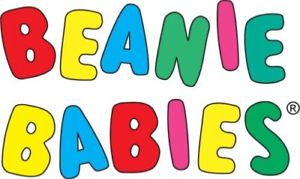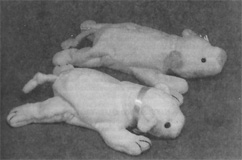Beanie Babies facts for kids
 |
|
| Type | Stuffed toy |
|---|---|
| Inventor(s) | Ty Warner |
| Company | Ty Inc. |
| Country | United States |
| Availability | 1993–present |
| Materials | Synthetic plush, polyvinyl chloride, polyester fiber |
Beanie Babies are popular stuffed toys. They were created by an American businessman named H. Ty Warner, who started his company, Ty Inc., in 1986. What makes Beanie Babies special is that they are filled with tiny plastic pellets, often called "beans," instead of the usual soft stuffing. Most Beanie Babies are shaped like different animals.
Even though they first came out in 1993, Beanie Babies became a huge fad and collectible in the late 1990s. They were even called the world's first Internet sensation in 1995! People collected them not just as toys, but also hoping they would become valuable, like a financial investment, because some rare ones could be sold for a lot of money.
Contents
How Beanie Babies Are Designed
Beanie Babies are made to be a bit "under-stuffed." This means they aren't packed full of stuffing. Some people thought this made them look "cheap" at first. But this special design actually made them different from other stuffed animals. It allowed you to pose them easily, and Ty Warner said it made them look more "real."
Special Tags and Poems
Another important part of Beanie Babies is their tags. Each Beanie Baby has two tags:
- A heart-shaped "swing tag" on top.
- A fabric "tush tag" on the bottom.
These tags have changed over the years. From 1994 to 1996, the swing tags had spaces to write "To" and "From" if you were giving them as gifts. Then, starting in 1996, the tags began to include a short, four-line poem about the Beanie Baby and its "date of birth." A person named Lina Trivedi wrote the poems for the first 136 Beanie Babies.
Sometimes, Beanie Babies were sent out with mistakes on their tags, like wrong spellings. These mistakes could actually make the toy even more valuable to collectors! Sometimes, the poems, birthdays, or even the names of certain Beanie Babies were changed.
Why Beanie Babies Became Collectible
Beanie Babies started becoming very popular collectibles in late 1995. They quickly became a hot toy. The company, Ty Inc., had a clever plan:
- They made only a limited number of each new design.
- They sent only a few of each design to stores.
- They regularly "retired" designs, meaning they stopped making them.
This plan created a huge market where people would buy, sell, and trade Beanie Babies. This made them even more popular and valuable to collectors.
The Beanie Baby Craze
Many people thought that all "retired" Beanie Babies would become very valuable. The collecting craze lasted until 1999. Then, Ty Inc. announced they would stop making Beanie Babies and released a special bear called "The End." However, after this announcement, Ty asked the public to vote on whether Beanie Babies should continue. Fans and collectors voted "overwhelmingly" to keep them!
At the peak of their popularity, people would buy Beanie Babies and then quickly sell them for much higher prices, sometimes ten times what they paid, especially on eBay. In fact, at one point, Beanie Babies made up 10% of all sales on eBay! Some serious collectors even insured their Beanie Babies for thousands of dollars.
Here are some reasons why Beanie Babies were so collectible:
- Unique Features: Each toy had a special birthday and poem printed on its tag.
- Limited Supply: There weren't enough Beanie Babies to meet everyone's demand.
- Special Stores: They were first sold only in small, local gift shops.
- New and Retired Designs: Several times a year, old designs would stop being made, and new ones would appear.
Ty Warner knew that the Beanie Baby craze might not last forever. So, he started asking stores that sold Beanie Babies to also sell his company's other toy lines. While these other toys weren't as popular as Beanie Babies, they helped keep the company going after the main fad ended. Some of these other lines eventually became successful on their own.
Beanie Babies and the Internet
Ty, Inc. was one of the very first companies to create a website to connect directly with their customers. This was a big reason why Beanie Babies became popular so quickly. When Ty's first website launched in late 1995, only a small number of Americans were using the Internet.
Visiting the Website
Along with the website launch, all Beanie Baby tags started to include the Ty website address (URL) and a message that said: Visit our web page!!! This encouraged many people to go online to learn more about Beanie Babies. This was a new idea at the time, and it helped make Beanie Babies the world's first Internet sensation.
Famous Beanie Babies
Princess the Bear
After Diana, Princess of Wales passed away in 1997, Ty Warner released a lavender Beanie Baby bear named Princess in her honor. Warner announced that all the money from selling this bear would go to the Diana, Princess of Wales Memorial Fund. The Princess bear was first sent to stores in late 1997. The very first ones are known as "PVC Princess Bears" because their tush tags say "P.V.C. Pellets." Later versions, made in 1998, say "P.E. Pellets" and are much more common.
Decade the Bear
Decade the bear was created in 2003 to celebrate Beanie Babies' 10th anniversary. These bears came in many colors like white, blue, red, purple, and more. Most Decade bears also have silver sparkles on them.
Tabasco the Bull (Snort)
This bull Beanie Baby was first named Tabasco. But to avoid problems with the company that makes Tabasco sauce, its name was changed to Snort. The original Tabasco bull has all-red feet, while Snort has all-white feet. The poem for this Beanie Baby stayed the same and hints at the Chicago Bulls basketball team:
"Although Snort is not so tall He loves to play basketball He is a star player in his dream Can you guess his favorite team?"
Peanut the Royal Blue Elephant
Peanut the royal blue elephant is one of the most famous Beanie Babies. It was first made in 1995 in a royal blue color. However, Ty realized the color was too dark and changed it to a lighter blue. They stopped making the royal blue version, and only about 500 were ever made. Because they are so rare, these royal blue Peanuts can sell for around $1,500 if they have their original tag!
Tremor the Dinosaur
Tremor was a special Beanie Baby because it was the first one to travel into space! This happened on May 30, 2020, during the Crew Dragon Demo-2 mission.
Fake Beanie Babies
As Beanie Babies became super popular, fake versions started to appear around 1997. At first, cheap copies of common Beanie Babies were sold at low prices.
Stopping the Fakes
Authorities worked to stop the sale of fake Beanie Babies in the late 1990s. People who were caught selling them faced legal trouble. For example, in 1998, authorities in England seized over 6,000 fake Princess and Britannia Beanie Babies. In 1999, a man in Minnesota was sent to prison, fined, and put on probation for being involved in selling fake Beanie Babies.
Beanie Babies in Media
Because Beanie Babies were so successful, special magazines were made just for them. One of the most popular was Mary Beth's Bean Bag World. This monthly magazine was all about Beanie Babies and other similar plush toys. It was published from 1997 to 2001.
Beanie Babies from Movies and TV Shows
In the late 2000s, Beanie Babies started to look like characters from popular children's movies and TV shows. Companies like Nickelodeon, DreamWorks, and Paramount partnered with Ty Inc.
You can find Beanie Babies of characters from:
- Nickelodeon cartoons like SpongeBob SquarePants, Dora the Explorer, Blue's Clues, and The Backyardigans.
- DreamWorks Animation movies like Shrek the Third.
- Ice Age: Dawn of the Dinosaurs from 20th Century Fox.
- Legend of the Guardians: The Owls of Ga'Hoole and Guardians of Ga'Hoole book series.
- Scooby-Doo, Hello Kitty, and Peanuts.
More recently, Beanie Babies have been made to look like Disney characters, including Mickey Mouse, Minnie Mouse, Winnie the Pooh, and Olaf from Frozen. They also have toys from the Disney Junior TV show Doc McStuffins, Pixar films like Cars and Finding Dory, and Marvel Comics superheroes.
Ty Inc. has also worked with Universal Pictures, Sony Pictures Animation, and Hasbro to create Beanie Babies from movies like Despicable Me, Sing, My Little Pony, and The Emoji Movie. Plus, they've added more Nickelodeon characters like those from PAW Patrol, Teenage Mutant Ninja Turtles, and Peppa Pig.
Images for kids



